Bryant A07047 Programmable Thermostat
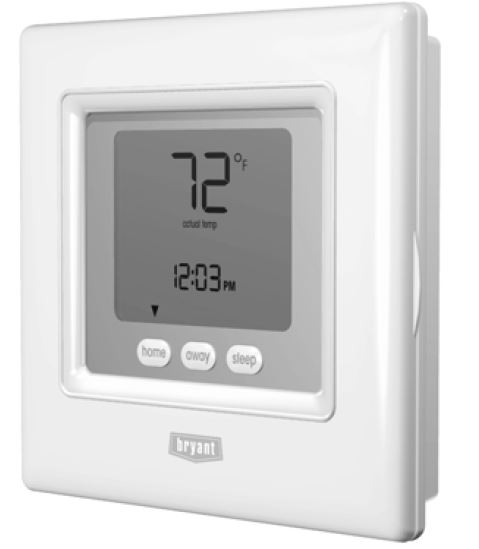
NOTE: Read the entire instruction manual before starting the installation.
SAFETY CONSIDERATIONS
Read and follow manufacturer instructions carefully. Follow all local electrical codes during installation. All wiring must conform to local and national electrical codes. Improper wiring or installation may damage a thermostat. Recognize safety information. This is the safety–alert symbol. When you see this symbol on the equipment and in the instruction manual, be alert to the potential for personal injury. Understand the signal words DANGER, WARNING, and CAUTION. These words are used with the safety–alert symbol. DANGER identifies the most serious hazards which will result in severe personal injury or death. WARNING signifies a hazard that could result in personal injury or death. CAUTION is used to identify unsafe practices which may result in minor personal injury or product and property damage. NOTE is used to highlight suggestions that will result in enhanced installation, reliability, or operation.
INTRODUCTION
Bryant’s Legacy Series programmable thermostats are wall–mounted, low–voltage thermostats which maintain room temperature by controlling the operation of a heating and/or air conditioning system. Both the heat pump and air conditioner models are available, each in programmable and non–programmable versions. A variety of features are provided including battery operation, separate heating and cooling setpoints, auto changeover, keypad lockout, backlighting, and built-in installer test. Programming features include 7–day (all days the same) and 5/2 (Mon–Fri and Sat-Sun) with 2 or 4 periods per day. This Installation Instruction covers the installation, configuration, and start-up of all four versions of the Legacy Series line of thermostats. For operational details, consult the Owner’s Manual for the specific thermostat you are installing.
INSTALLATION CONSIDERATIONS
Models
There are four models in the Legacy Series: programmable and non–programmable, AC and HP. Models T2–PAC and T2–NAC are designed for AC systems, controlling one stage of cooling and one stage of heating. They will not operate a heat pump. Models T2–PHP and T2–NHP are designed for HP systems, controlling two stages of cooling and three stages of heating. They can be converted to AC operation. Select the appropriate model for the intended application.
Power
All Legacy Series models are dual-powered. They can operate from batteries or 24VAC power. Operation from 24VAC is preferred if available. Battery operation is used when there are not enough wires to support 24VAC operation or when “armchair programming” is desired. For an AC system, up to six wires are needed for 24VAC operation and one less wire for battery operation. For a HP system, up to seven wires are needed for 24VAC operation and one less wire is sufficient for battery operation. For heat-only operation with batteries, only two wires are required. When battery operation is used, the C terminal does not need to be connected. Provision is also made for separate heating and cooling transformers via separable Rc and Rh terminals which are connected via factory–installed jumper wire.
Step 1 — Thermostat Location
- Approximately 5 ft (1.5m) from the floor.
- Close to or in a frequently used room, preferably on an inside partitioning wall.
- On a section of wall without pipes or ductwork.
The thermostat should NOT be mounted
- Close to a window, on an outside wall, or next to a door leading to the outside.
- Exposed to direct light or heat from the sun, a lamp, fireplace, or other temperature–radiating objects which could cause a false reading.
- Close to or in direct airflow from supply registers and return–air registers.
- In areas with poor air circulation, such as behind a door or in an alcove.
Step 2 — Install the Thermostat
WARNING
ELECTRICAL OPERATION HAZARD
Failure to follow this warning could result in personal injury or death. Before installing the thermostat, turn off all power to the equipment. There may be more than one power disconnect
- Turn OFF all power to the unit.
- If an existing thermostat is being replaced:
- Remove the existing thermostat from the wall.
- Disconnect wires from the existing thermostat, one at a time. Be careful not to allow wires to fall back into the wall.
- As each wire is disconnected, record the wire color and terminal marking.
- Discard or recycle the old thermostats.
- Open the thermostat (mounting base) to expose mounting holes. The base can be removed to simplify mounting. Press the thumb release at the top of the thermostat and snap it apart carefully to separate the mounting base from the remainder of the thermostat.
- Route thermostat wires through large holes in the mounting base. Level the mounting base against the wall (for aesthetic value only—the thermostat need not be leveled for proper operation) and mark the wall through four mounting holes. To avoid unintended bending of wall plate plastic, all four screws and anchors must be used. See Fig. 1.
- Drill four 3/16–in. mounting holes in the wall where marked.
- Secure mounting base to wall with four screws and anchors provided. To avoid unintended bending of wall plate plastic, all four screws and anchors must be used. Make sure all wires extend through the hole in the mounting base.
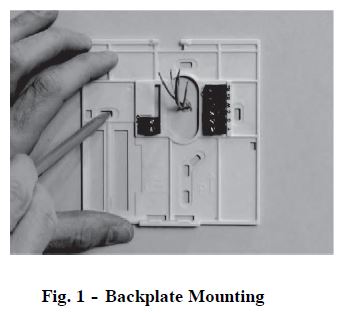
- Adjust the length and routing of each wire to reach the proper terminal and connector block on the mounting base with 1/4–in. (6 mm) of extra wire. Strip only 1/4 in. of insulation from each wire to prevent adjacent wires from shorting together when connected. See Fig. 2.
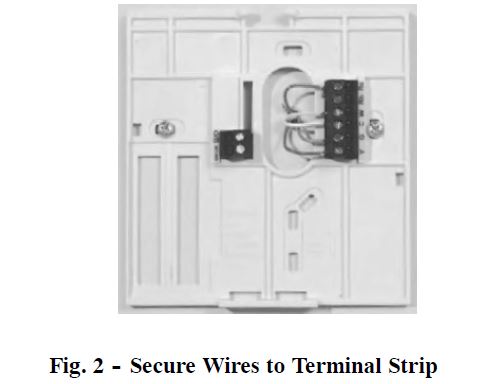
- Match and connect equipment wires to the proper terminals of the connector blocks (see Fig. 3). If there are separate 24VAC transformers, one in the indoor unit and one in the outdoor unit, connect the common of each to the C terminal.
Remove factory-installed jumper wire from Rc and Rh terminals. Connect the R from the indoor unit to the Rh terminal. Connect the R from the outdoor unit to the Rc terminal. Then the W signal is taken from the Rh power and the Y1, Y/Y2, G, and O signals are taken from the Rc power.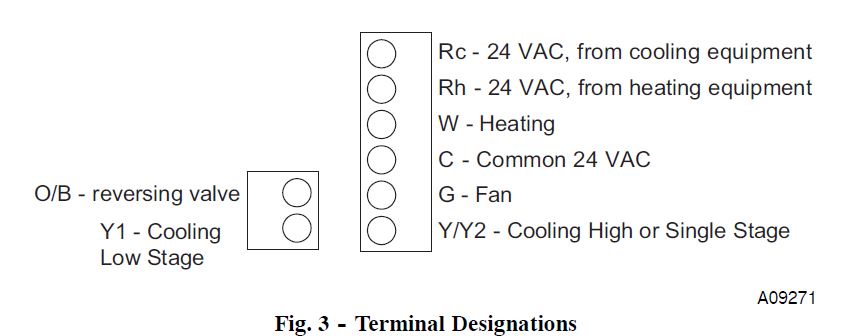
- Push any excess wire into the wall and against the mounting base. Seal the hole in the wall to prevent air leaks. Leaks can affect operations.
- Snap the case back together. Attach thermostat to backplate by inserting tab on the bottom edge and hinging up until top snap secures. See Fig. 4
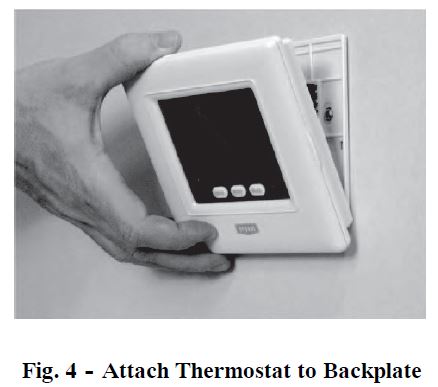
- Close the thermostat assembly making sure the pins on the back of the circuit board align with the sockets in the connector.
- Turn ON the power to the unit.
CAUTION
ENVIRONMENTAL HAZARD
Failure to follow this caution may result in environmental damage. Mercury is a hazardous waste. Federal regulations require that Mercury be disposed of properly. When power is applied, all display icons are lit for 2 seconds to test the display.
Following this, the equipment type for which the thermostat is configured is displayed for an additional 2 seconds. It will be one of HP, H2, AC, A2, H or C (see explanation under Step 3, Option 01 below). An HP thermostat configured to operate an AC (see Option 1 below) will display AC. An AC thermostat cannot display HP.
NOTE: If a common wire has not been connected, two AA batteries must be used to power the thermostat.
Step 3 — Set Thermostat Configuration
Configuration options enable the installer to configure the thermostat for a particular installation. Most are not presented to the homeowner and therefore must be properly set by the installer. (Only those marked with an asterisk * below are available to the homeowner.) Following is a list of the options available, an explanation of their function,and their factory default settings. Not all numbers are used in the Legacy Series because not all options are available in this series — and numbering is consistent across the T1, T2, and T6 thermostat lines.
Configuration Options — Summary
- Option 01 — Equipment type
- Option 03* — Fahrenheit/Centigrade
- Option 04 — Fan (G) on with W output
- Option 07 — Zoning
- Option 10 — Reversing valve
- Option 11 — Minimum deadband between heating and cooling setpoints
- Option 12 — Smart Recovery (programmable models only)
- Option 13 — Room air temperature offset adjustment
- Option 15 — Auto Changeover availability
- Option 16 — Maximum cycles per hour
- Option 17 — Time between equipment stages
- Option 18* — Continuous backlighting
- Option 21* — Keypad lockout
- Option 24* — Programmable/non–programmable (programmable models only)
- Option 25* — Number of programmable periods per day
- Option 26 — Minimum cooling setpoint
- Option 27 — Maximum heating setpoint
- Option 99 — Reset to factory defaults
Those options marked with an asterisk are also adjustable by the homeowner. See the Owner’s Manual for further information.
To Enter the configuration mode
Press and hold the FAN key for about 10 seconds until the display changes so that only two pairs of digits are showing. The left (programmable version) or the large upper (non–programmable version) display shows the configuration number and the right (programmable version) or small lower (non–programmable version) shows the configuration setting. Configuration number will be flashing which means it can be adjusted using the UP and DOWN keys. To cause the opposite pair to flash (to be adjustable), press the MODE key. Successive presses of the MODE key alternate between the configuration number and the configuration setting. To exit the configuration mode, press the FAN key. If no key is pressed for 3 minutes, the configuration mode will automatically exit, returning the thermostat to normal operation.
Configuration Options — Selection
Option 01 — Equipment type
Selections: with HP thermostat: HP, H2, AC, A2, H, C with AC thermostat: AC, H, C
- HP controls a 1-speed heat pump with 1 stage of aux heat.
- A2 controls two stages of cooling and one stage of furnace heat.
- H2 controls a 2 Speed HP with 1 stage of aux heat.
- AC controls a 1-speed air conditioner with 1 stage of heat.
- H operates a heat-only system: a furnace or fan coil only; no outdoor unit.
- C operates a cool-only system: outdoor AC unit with an indoor fan coil; no strip heater support.
Note that this option allows an HP thermostat to be converted to control an AC system.
Option 03 — Fahrenheit/Centigrade
Selections:
F = Fahrenheit — Default is Fahrenheit.
C = Centigrade.
Selects temperature measurement units.
Option 04 — Fan (G) ON with output
Selections:
OF = G not energized with W — This is the default.
ON = G energized with W.
This selection determines whether the fan (G) is to be ON or OFF when the W (furnace or strip heat) is ON. Furnaces and fan coils which manage their own blowers do not require a separate G signal. Some auxiliary heaters require a
separate G signal to operate the blower when W is applied.
Option 07 — Zoning
Selections:
OF = non–zoned system — This is the default.
ON = zoned system.
ON disables the thermostat’s internal timers which are not needed with zoning system controls. Must be set to OF for non–zoned systems.
Option 10 — Reversing valve
This selection is only available on heat pump systems. The “O” terminal can be configured to be energized in either heating mode or in cooling mode, depending on the heat pump operation. “O” is used to describe a heat pump system that energizes its reversing valve in cooling. “B” is used to describe a heat pump system that energizes its reversing valve in heating.
H — Reversing valve output (O/W2/B) is energized when HEAT mode is selected.
C — Reversing valve output (O/W2/B) is energized when the COOL mode is selected.
The default is C.
Option 11 — Minimum Deadband Between Heating And Cooling
Selections:
01 through 06 — Default is 02.
Sets the minimum allowable number of degrees between heating and cooling setpoints. One setpoint will “push” the other to maintain this difference.
Option 12 — Smart Recovery (programmable model only)
Selections:
OF, 30, 60, 90 — Default is 90. Smart Recovery OF means setpoints change immediately at a program schedule change. Thirty, 60, or 90 select the number of minutes recovery starts before the programmed recovery time. Recovery takes place smoothly during the selected recovery time, ending at the recovery time and temperature which is programmed. If the setpoint is changed during smart recovery, the smart recovery is canceled and the new setpoint is effective immediately. Not available with non–programmable thermostats.
Option 13 — Room Air Temperature Offset
Selections:
–5 to 5_ F — Default is 0. This option selects the number of degrees F to be added to the displayed temperature to calibrate or deliberately miscalibrate the measured room temperature.
Option 15 — Auto Changeover Availability
Selections:
ON — This is the default.
OF
ON allows the automatic changeover between heating and cooling as demand requires.
OF maintains either heating or cooling mode only. Auto changeover is not available when H or C is selected under Option 1.
Option 16 — Maximum Cycles Per Hour
Selections:
2, 4, or 6 — Default is 4.
The maximum cycle rate is limited by internal timers to the selected number of cycles per hour. The selection of a higher number causes faster cycling resulting in a more constant room temperature.
Option 17 — Minimum Time Between Equipment Stages
Selections:
10, 15, 20, 25 — Default is 15.
When there is an auxiliary stage of heat available, this is the amount of time the heat pump must operate before the aux stage can turn on. With heat pumps, longer times can reduce the amount of auxiliary heat used. Not available with AC thermostats
Option 18 — Backlight Configuration
Selections:
ON, OF — Default is OF. When ON is selected and the thermostat is not battery operated a low-level continuous display backlight is always on. With OF selected, the backlight is only on for a short time after the door is opened or a key is pressed. Continuous backlight is not available with battery operation.
Option 21 — Keypad Lockout
Selections:
ON, OF — Default is OF. With OF selected, the keypad cannot be locked. With ON selected the keypad will be locked and can be unlocked by simultaneously pressing the UP and DOWN keys for 5 seconds. Once unlocked, it will relock 2 minutes after the last keypad press. A “lock” icon is displayed while it is locked.
Option 24 — Programmable/Non–Programmable (programmable model only)
Selections:
P, nP — Default is P. This option is only available on programmable models, allowing programming to be disabled when nP is selected. The clock is displayed, but the program schedule, the HOLD and TEMPORARY HOLD functions are disabled.
Option 25 — Number of Programmable Periods (programmable models only)
Selections:
2, 4 — Default is 4. Selecting 2 allows 2 programming periods, P1 and P2, per day. Selecting 4 allows periods P1, P2 , P3, and P4. Not available with non–programmable thermostats.
Option 26 — Minimum Cooling Setpoint
Selections:
52_F to 90_F — Default is 52_F.
Sets the lowest cooling setpoint available to the user.
Option 27 — Maximum Heating Setpoint
Selections:
50_F to 88_F — Default is 88_F.
Sets the highest heating setpoint available to the user.
Option 99 — Reset to Factory Defaults
Selection:
See below — There is no default. Use this capability to reset the thermostat to “out of the box” conditions.
NOTE: All configuration settings, program settings, clock, and day which have been manually entered will be lost! When this option is selected, the configuration number (99), will appear on the left and 10 will appear on the right. To perform the reset, first, use the MODE key to make the 10 flashes. Then press and hold the DOWN key. The 10 will start counting down toward zero. If the DOWN key is kept pressed until the count reaches zero, the reset will be performed. If the DOWN key is released early, the number will return to 10 and the reset will not occur.
Step 4 — Check Thermostat Operation
The Legacy Series thermostats have a built-in installer test capability. Use it to check thermostat and equipment operation without delays or setpoint adjustments to force heating or cooling. To enter the Installer Test mode, use the same process as is used to enter Installer Configuration, only hold the FAN key longer. More specifically, press and hold the FAN for about 15 seconds until the display reads In on the left and St on the right for the programmable model or InS in the smaller display for the non–programmable model. The MODE will be OFF. The MODE key (upper left) can now be used to select heat, cool, or emergency heat, if this is a HP thermostat. Selecting one of the available modes will immediately command the equipment to turn on in that mode. It will run for 3 minutes and then return the mode to off.With HP thermostats (having 2 stages of heating), the test will run for 3 minutes on each stage. If the thermostat is programmable, the clock display counts down from 180 seconds while each stage operates. Changing the mode to OFF will terminate any running test immediately. During any test, the display icons will be displayed the same as for normal operation of that stage, as follows:
| SELECTED MODE | DISPLAY ICONS |
| off | off |
| cool | cool on |
| heat | heat on, aux heat on |
| Em Heat | aux heat on |
To terminate the Installer Test mode press the DONE or FAN button. If the thermostat is left in Installer Test mode, it will revert back to normal operation after 15 minutes
Checklist
- Run equipment through several heating and cooling cycles to ensure proper operation. To operate the thermostat in its normal operating mode, consult the Owner’s Manual.
- If the equipment is to be left in operation, the setpoints, operating mode, and possibly program schedule must be properly selected.
- Put away tools and instruments and clean up debris.
- Review and leave Owner’s Guide with the owner.
FEATURES AND ACCESSORIES
Home, Away, Sleep (programmable models only)
This feature provides three button selections that select from three predetermined pairs of heat and cool setpoints. In programmed versions, one of these three choices can be selected for any programmed period. To change these settings, a temperature is first selected and then the key is pressed and held, similar to setting stations on a push–button radio. See Owner’s Manual for details.
Clock (programmable models only)
Without batteries, the clock will continue to operate for 8 hours while power is removed. With batteries, the clock operates until the end of the battery life.
Batteries
Battery operation is available for installations where there is no common (C) wire available at the thermostat or where operation is to continue while the thermostat is removed from the wall, usually to facilitate remote (armchair) programming. For battery operation, install two alkaline AA batteries. The thermostat is designed to operate up to one year on a set of batteries. A battery indicator on the display warns when battery replacement is needed. See Homeowners Guide for details. If batteries are installed and the thermostat is operated from 24VAC power, battery operation will occur only when 24VAC power is not present. The changeover between 24VAC power and battery power is automatic.
Display Lighting
The display has two levels of lighting, high level, and low level. High-level lighting comes on for 10 seconds when the door is opened and/or buttons are being pressed with 24VAC and with batteries. Low-level lighting is only available if the
thermostat is operated from 24VAC. It is not available with batteries. The low level can be selected (see Option 18) for continuous backlight.
Door Switch
When the door is opened, the display changes from its normal operation view. The large temperature display disappears so it will be available for other user functions. If the door is left open for 3 minutes, the display reverts to normal operation.
Mounting Options
For those installations requiring it, mounting hole locations for the programmable model are spaced to fit either a horizontal or vertical junction box. Mounting hole locations for the non–programmable are spaced to fit a horizontal junction box.
OPERATIONAL AND CONNECTION INFORMATION
Rc/Rh Connections
For installations having a separate 24VAC transformer for heating and cooling, the R connection can be separated into two connections, one for each transformer. This allows isolation between the two transformers to be preserved. To separate Rc from Rh, remove the factory-supplied jumper between the Rc and Rh terminals. The Rh terminal powers the W output. The Rc terminal powers the Y1, Y/Y2, G, and O outputs.
Wiring
For all wiring applications, use 22 AWG or larger wire. Continuous wire lengths over 100 ft. (30.5 m) should use 20 AWG or larger. Wire lengths are not to exceed 250 ft. (76 m) per run.
O/B Terminal — On HP Thermostat Only
This terminal is normally connected to the reversing valve of the heat pump. It is called O when the valve is energized in cooling and B when it is energized in heating. Option 10 of the Configuration Options make the O/B selection.
Timers
There are several timers that influence the thermostat’s operation: If any of the timers listed below is preventing the equipment from turning on, the display icons that show the equipment is operating will be flashing to indicate a turn–on delay is present.
Five–Minute Compressor Timeguard
This timer prevents the compressor from starting unless it has been off for 5 minutes. It can be defeated for one cycle by simultaneously pressing the FAN and UP keys.
Minimum On Timer
Once the equipment has been turned on, it must remain on for 3 minutes. A change in mode or setpoint will cancel this timer.
Cycle Timer
Based on the selection of 2, 4, or 6 cycles per hour, this timer is set to 30, 15, or 10 minutes. This much time must elapse from the start of one cycle before another cycle can start. It serves to impose the cycles per hour limits. It can be defeated for one cycle by simultaneously pressing the FAN and UP keys.
Auto Changeover Timer
To prevent unnecessary cycling between heating and cooling modes, this timer prevents a changeover to the opposite mode until a demand exists in the opposite mode for 20 minutes. It is defeated when setpoints are changed so that the opposite mode is immediately available if desired.
Error Codes
Two error messages indicate problems with the thermostat’s operation. If the room temperature sensor fails, the temperature display will show —-, two dashes. If there is an internal memory failure, the temperature display will show E4. The remedy for each of these is to replace the thermostat. Table 1 shows the thermostat outputs for each available stage of heating or cooling. It may be useful in checkout or troubleshooting.
| Equip Config | Tstat Model | COOL STG 1 | COOL STG 2 | HEAT STG 1 | HEAT STG 2 | HEAT STG 3 | EM HEAT |
|
SS AC Opt 1 = AC |
T2 — PAC
T2 — NAC T2 — PHP T2 — NHP |
Y |
— — |
W |
— — |
— — |
— — |
| SS HP Opt 1 = HP RVS = O Opt 10 = C |
T2 — PHP T2 — NHP |
Y, O/B |
— — |
Y |
Y, W |
— — |
W |
| SS HP Opt 1 = HP
RVS = B Opt 10 = H |
T2 — PHP T2 — NHP |
Y |
— — |
Y, O/B |
Y,
W, O/B |
— — |
W |
| 2SPD AC Opt 1 = A2 | T2 — PHP
T2 — NHP |
Y1 | Y1, Y | W | — — | — — | — — |
| 2SPD HP Opt 1 = H2 RVS = O Opt 10 = C |
T2 — PHP T2 — NHP |
Y1, O/B |
Y1,
Y, O/B |
Y1 |
Y1, Y |
Y1,
Y, W |
W |
| 2SPD HP Opt 1 = H2 RVS = B Opt 10 = H |
T2 — PHP T2 — NHP |
Y1 |
Y1, Y |
Y1, O/B |
Y1,
Y, O/B |
Y1,
Y, W, O/B |
W |
|
Heat Only Opt 1 = H |
T2 — PHP
T2 — NHP T2 — P AC T2 — NAC |
— — |
— — |
W |
— — |
— — |
— — |
| Cool Only Opt 1 = C | T2 — PAC
T2 — NAC |
Y | — — | — — | — — | — — | — — |
| Cool Only Opt 1 = C | T2 — PHP
T2 — NHP |
Y1 | Y1,Y | — — | — — | — — | — — |
WIRING DIAGRAMS
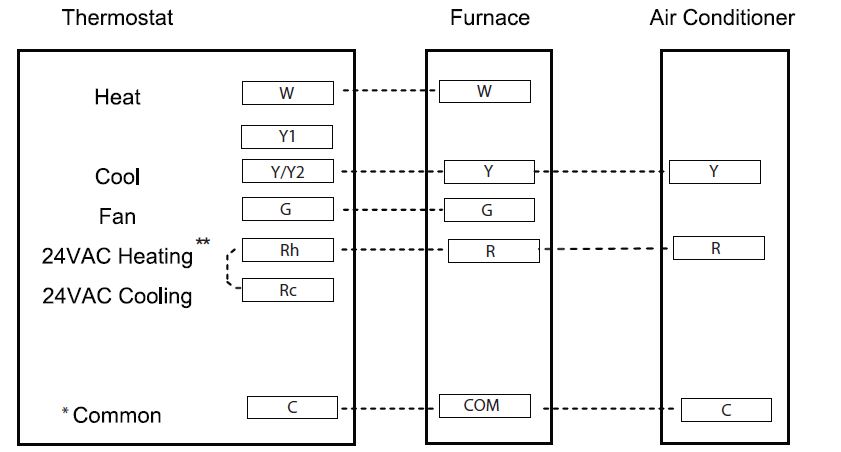
- wire not needed for batteries
- Remove the jumper when using split power (Indoor and Outdoor units utilize separate transformers
WIRING DIAGRAMS (cont.)
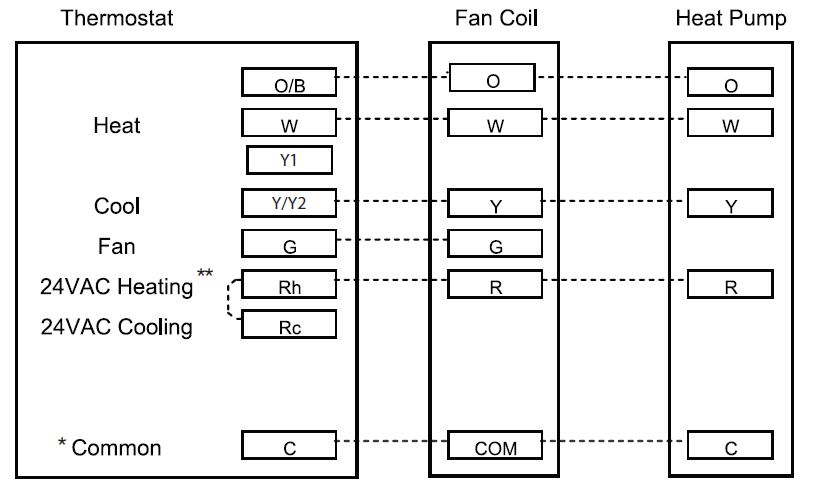
- C wire is not needed for batteries
- Remove jumper when using split power (Indoor and Outdoor units utilize separate transformers).
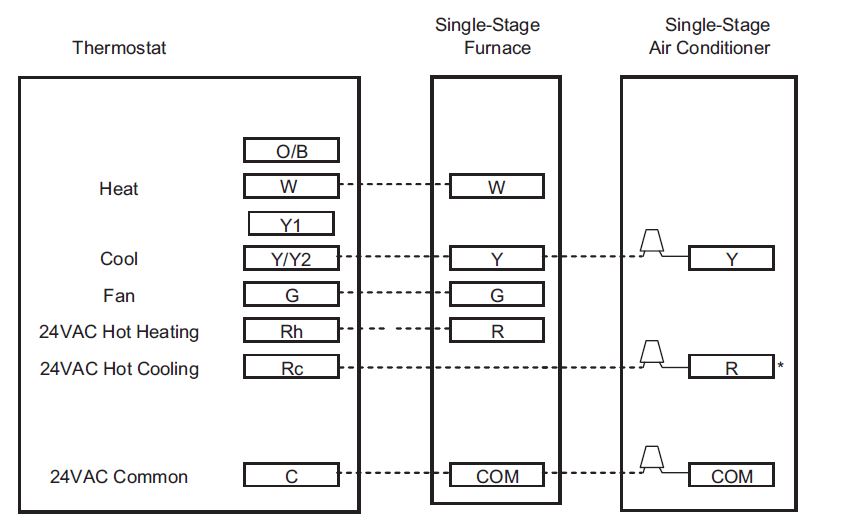
- Indicates connection may not be required/available
NOTE: Rc/Rh jumper is cut or removed on the thermostat
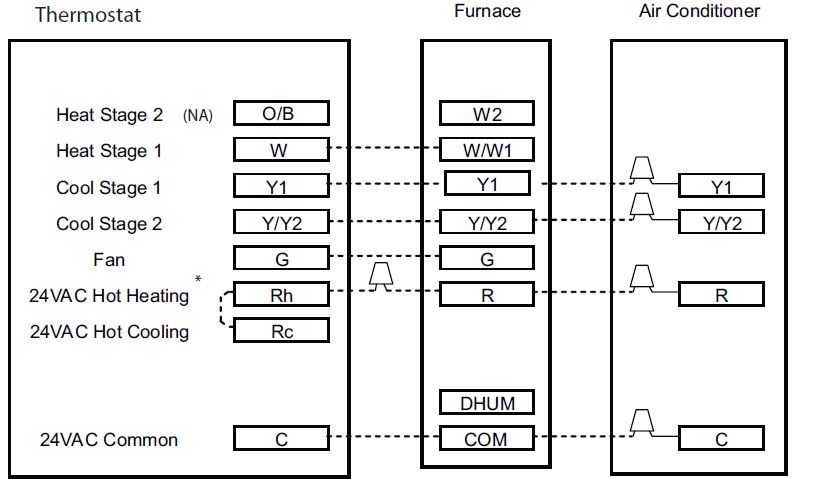
Remove the jumper when using split power (Indoor and Outdoor units utilize separate transformers).

- Some heat pumps may designate W1.
- Remove the jumper when using split power (Indoor and Outdoor Units utilize separate transformers).
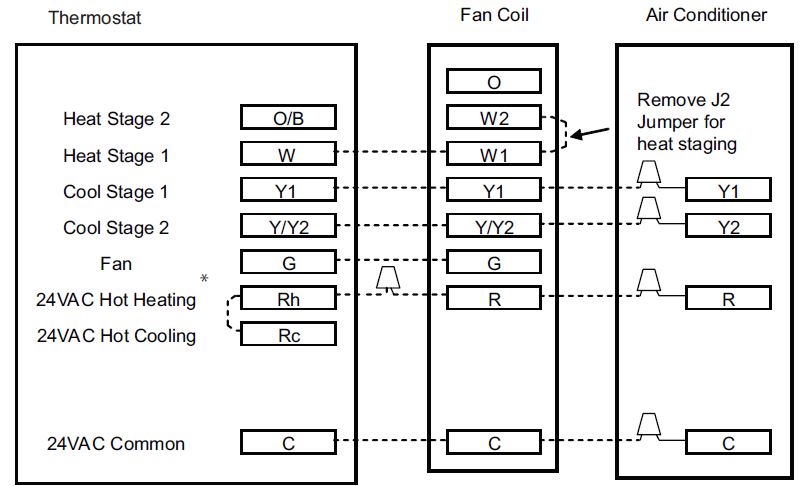
- Remove the jumper when using split power (Indoor and Outdoor units utilize separate transformers).
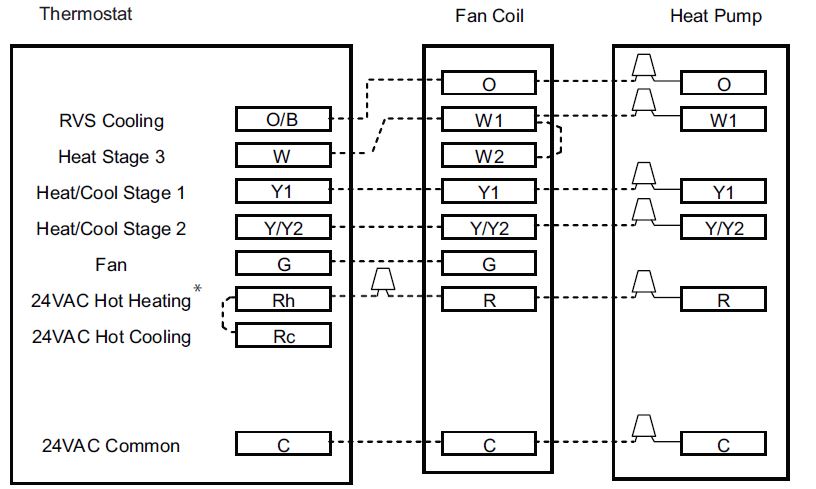
- Remove the jumper when using split power (Indoor and Outdoor units utilize separate transformers).
THERMOSTAT CONFIGURATION RECORD
Installer
_________________________
Model Number
_____________________________
Date
_______________________
- Hardware Configuration
__________ Seal Hole In Wall - Mode Settings
__________ Mode (Off, Heat, Cool, Auto, Em Heat)
__________ Heating Setpoint Value
__________ Cooling Setpoint Value
__________ Fan (Auto or On) - Home, Away, Sleep Settings
Heat Cool
Home ____ ____
Away ____ ____
Sleep ____ ____ - Schedule (For Programmable Thermostats)
Period 1 Period 2 Period 3 Period 4
Time Heat Cool Time Heat Cool Time Heat Cool Time Heat Cool
All
Days ____ ____ ____ ____ ____ ____ ____ ____ ____ ____ ____ ____
Week—
days ____ ____ ____ ____ ____ ____ ____ ____ ____ ____ ____ ____
Week—
end ____ ____ ____ ____ ____ ____ ____ ____ ____ ____ ____ ____
Configuration Options
- Option 01 ____ Equipment Type
- Option 03* ____ Fahrenheit/Centigrade Selection
- Option 04 ____ Fan (G) on with W/W1 Selection
- Option 07 ____ Zoning
- Option 10 ____ Reversing Valve
- Option 11 ____ Minimum Deadband Between Heating and Cooling Setpoints
- Option 12 ____ Smart Recovery (programmable models only)
- Option 13 ____ Room Air Temperature Offset Adjustment
- Option 15 ____ Auto Changeover Availability
- Option 16 ____ Cycles Per Hour
- Option 17 ____ Time Between Equipment Stages
- Option 18* ____ Backlight Configuration
- Option 21* ____ Keypad Lockout
- Option 24* ____ Programmable / Non—Programmable (programmable models only)
- Option 25* ____ Number of Programmable Periods Per Day (programmable models only)
- Option 26 ____ Minimum Cooling Setpoint
- Option 27 ____ Maximum Heating Setpoint
* Options with an asterisk can also be set/changed by the homeowner.
Copyright 2012 Bryant Corporation 7310 W Morris St. Indianapolis, IN 46231 IIT2—PAC—05 Replaces: IIT2— PAC— 04 Edition Date: 05/12 The manufacturer reserves the right to change, at any time, specifications and designs without notice and without obligations.
REFERENCE:
Download Manual:
Bryant A07047 Programmable Thermostat Installation Instructions

Bryant A07047 Programmable Thermostat Installation Instructions
The post Bryant A07047 Programmable Thermostat Installation Instructions appeared first on thermostat.guide.
source https://thermostat.guide/bryant/bryant-a07047-programmable-thermostat-installation-instructions/
No comments:
Post a Comment